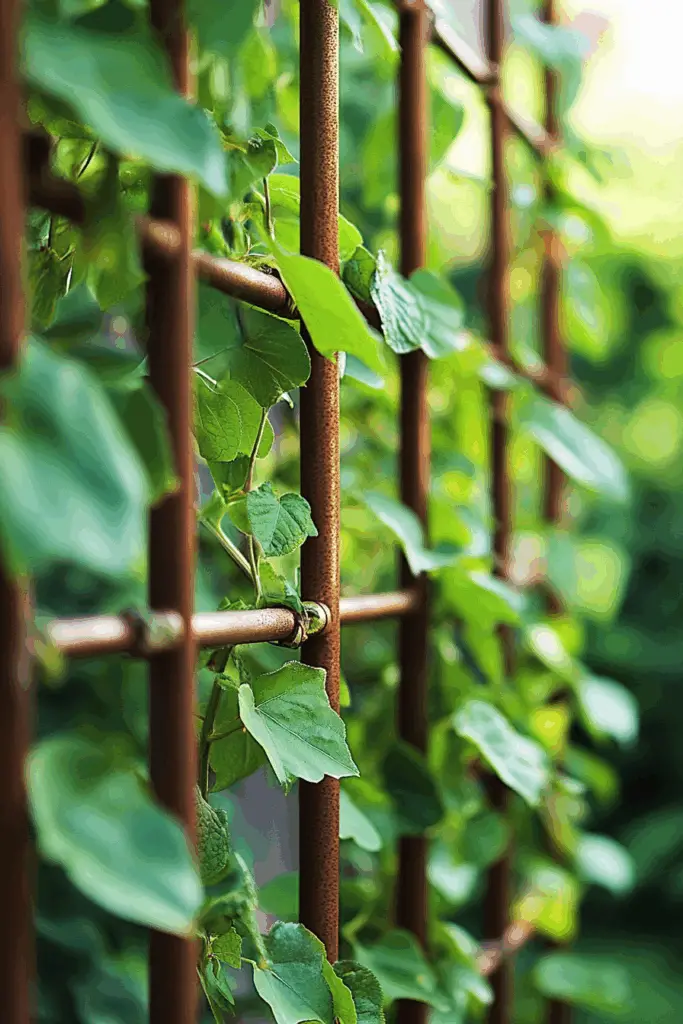Creating a thriving, organized garden often comes down to smart support—and that’s where DIY garden trellis ideas come into play. If you’ve ever watched your beautiful climbing plants sprawl uncontrollably or collapse under their own weight, you’re not alone. I’ve been there too. A few seasons ago, I cobbled together a flimsy trellis from scrap wood, only to watch it buckle under the weight of my vigorous morning glories by midsummer.
That experience led me down a rabbit hole of finding trellis solutions that are not only budget-friendly but also sturdy, tall, and manageable. Whether you’re growing peas, roses, or cucumbers, a good trellis can dramatically improve plant health, ease of maintenance, and garden aesthetics. In this article, I’ll walk you through ten creative and functional trellis ideas that suit a variety of styles, materials, and skill levels—so your garden gets the support it deserves.
1. Copper Pipe Trellis
Materials Needed:
- Copper pipes (½ inch or ¾ inch diameter)
- Copper fittings (elbows and T-joints)
- Pipe cutter
- Optional: Soldering kit for extra stability
Why You’ll Love It:
A copper pipe trellis is more than just functional—it’s a stylish statement in your garden. The natural patina that develops over time gives it a charming, aged look that complements everything from modern raised beds to classic cottage-style gardens.
Beyond its visual appeal, copper is incredibly durable and weather-resistant. You can customize the height and shape to suit your space—whether it’s a grid-style trellis for peas or a fan-shaped frame for climbing roses. For those who enjoy a hands-on project and want a long-lasting solution, this is a top-tier option.
Pro Tip:
If you’re not up for soldering, simply use pressure-fit connectors to assemble the frame. For added support, drive the base into the soil or anchor it into a raised bed frame.
2. Pallet Trellis
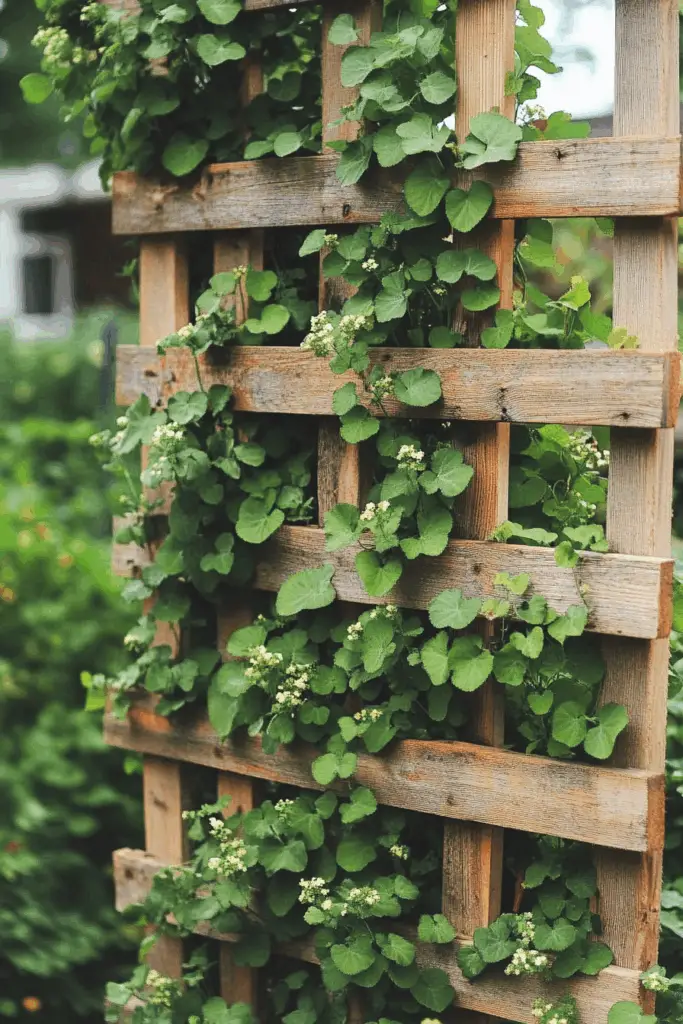
Materials Needed:
- Wooden pallet (heat-treated is best)
- Sandpaper
- Optional: Paint or wood stain for a finished look
Why You’ll Love It:
If sustainability and budget-friendliness are your priorities, a pallet trellis is a perfect fit. Wooden pallets are easy to source—often free from garden centers or warehouses—and make for an incredibly versatile vertical growing solution.
With a little sanding and optional painting, you can turn a humble pallet into a rustic yet practical trellis. It’s especially great for small spaces, like balcony gardens or compact backyard beds, where vertical growing is essential. Whether leaned against a wall or staked upright, it’s an eco-conscious way to support everything from peas to nasturtiums.
Pro Tip:
Be sure to use heat-treated (marked “HT”) pallets rather than chemically treated ones to ensure safety for your plants and soil. Add hooks or garden twine between slats for extra support as plants grow.
3. Wire Mesh Trellis
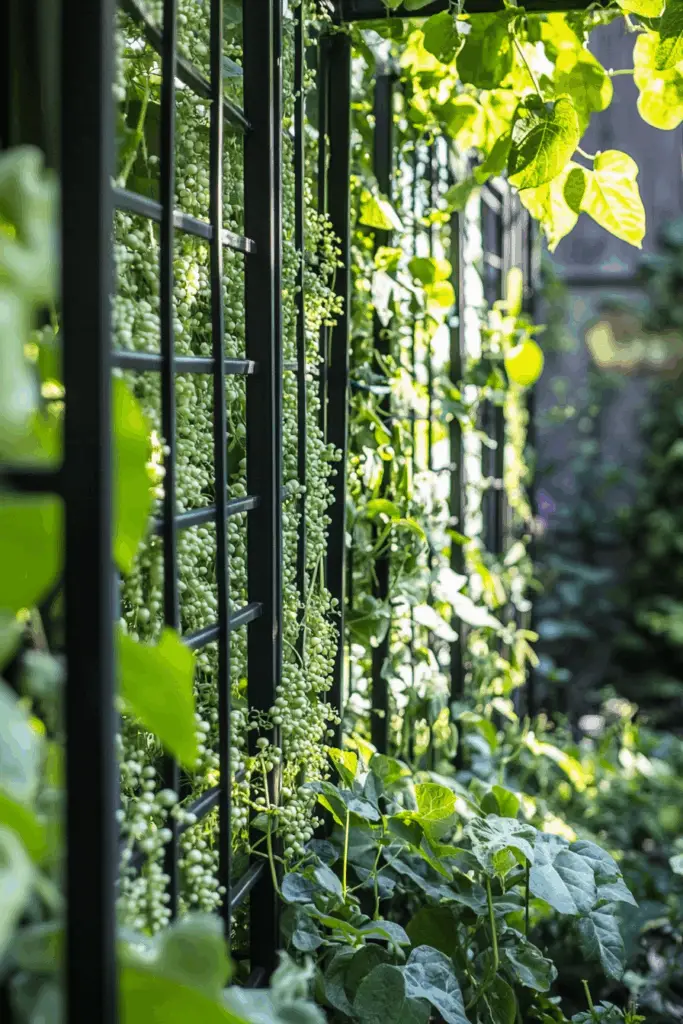
Materials Needed:
- Galvanized wire mesh panel
- Wooden or metal frame (optional, for added support)
- Zip ties, screws, or garden staples
Why You’ll Love It:
A wire mesh trellis is a powerhouse when it comes to supporting heavy climbers like tomatoes, cucumbers, or pole beans. The grid structure of galvanized mesh makes it easy for tendrils to latch on and climb, providing excellent airflow and light exposure for healthy growth.
This type of trellis is highly durable, especially when using galvanized materials that resist rust and corrosion. Whether framed or left as a simple panel, it can be staked vertically in the ground or angled over beds to create a tunnel effect—perfect for harvesting from both sides!
Pro Tip:
Frame the mesh with pressure-treated lumber for a polished, long-lasting structure. If you’re short on space, mount it against a fence or wall to save room while still going vertical.
4. PVC Pipe Trellis
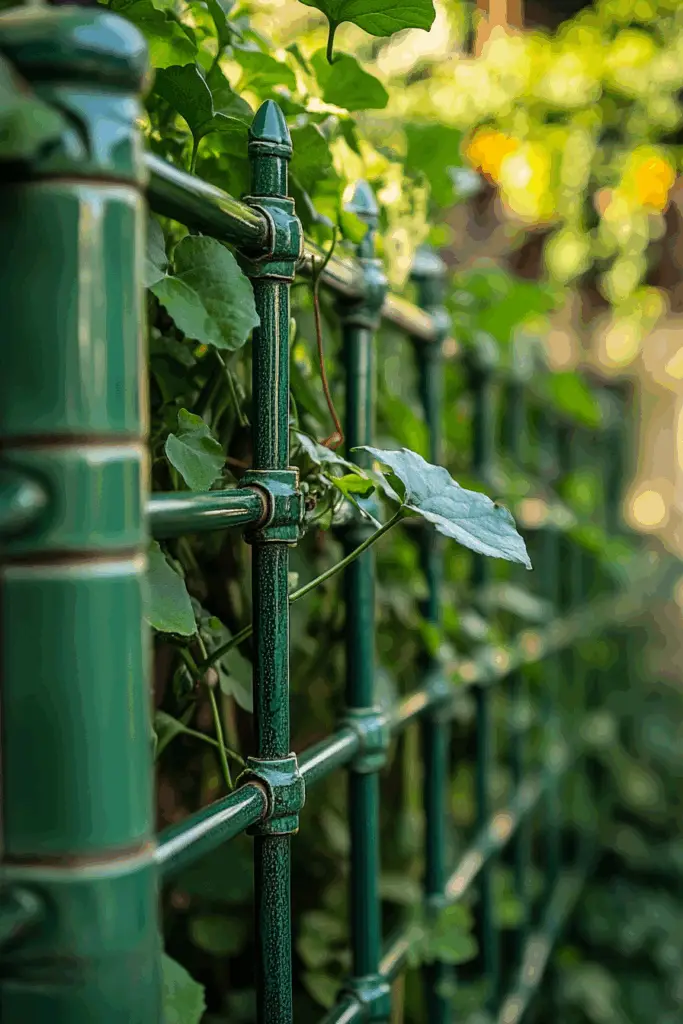
Materials Needed:
- PVC pipes (¾ inch recommended)
- PVC fittings (elbows, tees, and connectors)
- Garden mesh, nylon netting, or twine
- Pipe cutter or saw
Why You’ll Love It:
For gardeners who want a simple, customizable, and weather-resistant solution, a PVC pipe trellis is hard to beat. It’s incredibly lightweight, which makes it easy to move or adjust as your garden layout evolves. Plus, the material stands up well to rain, sun, and even snow, making it a long-term fixture in any climate.
You can build just about any shape or size you need—flat panels, arches, or A-frames—by snapping pipes together with fittings. Add netting or twine across the frame for vines and vegetables to climb. It’s an excellent choice for beans, peas, cucumbers, and even lightweight flowering plants.
Pro Tip:
Paint the PVC with a UV-resistant spray paint to blend it into your garden design and protect it from sun damage over time. Label different sections if you’re using it to support multiple plant types!
5. Freestanding Ladder Trellis
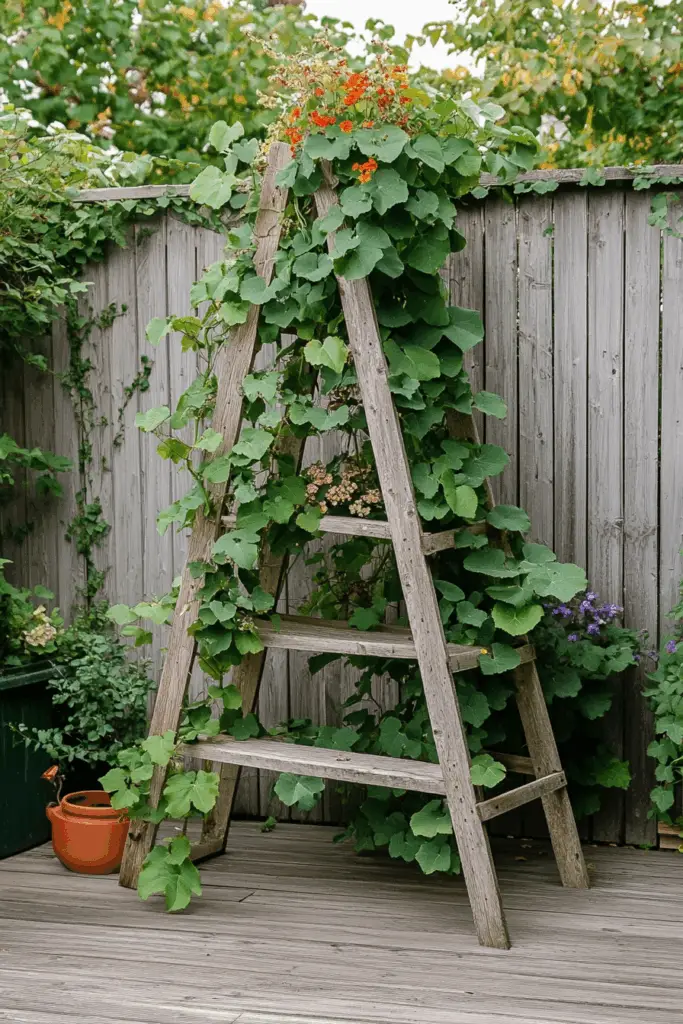
Materials Needed:
- Two old wooden ladders (or one ladder split in half)
- Hinges or chain to connect the tops
- Optional: Wood stain or exterior paint
Why You’ll Love It:
A freestanding ladder trellis is a beautiful blend of form and function. Repurposing old ladders into a trellis structure creates a rustic, farmhouse-style feature that’s ideal for flowering vines like clematis or morning glories.
Simply connect two ladders at the top with hinges or a chain, and you’ve got an A-frame trellis that’s both portable and sturdy. This setup is great for gardeners who like to move things around with the seasons or need an easy-to-store option during winter. You can even add shelves or planks between rungs to support potted plants or decor.
Pro Tip:
Look for ladders at thrift stores or salvage yards. Before placing them in the garden, give them a light sanding and seal with weatherproof finish to increase their longevity.
6. Chevron-Patterned Trellis
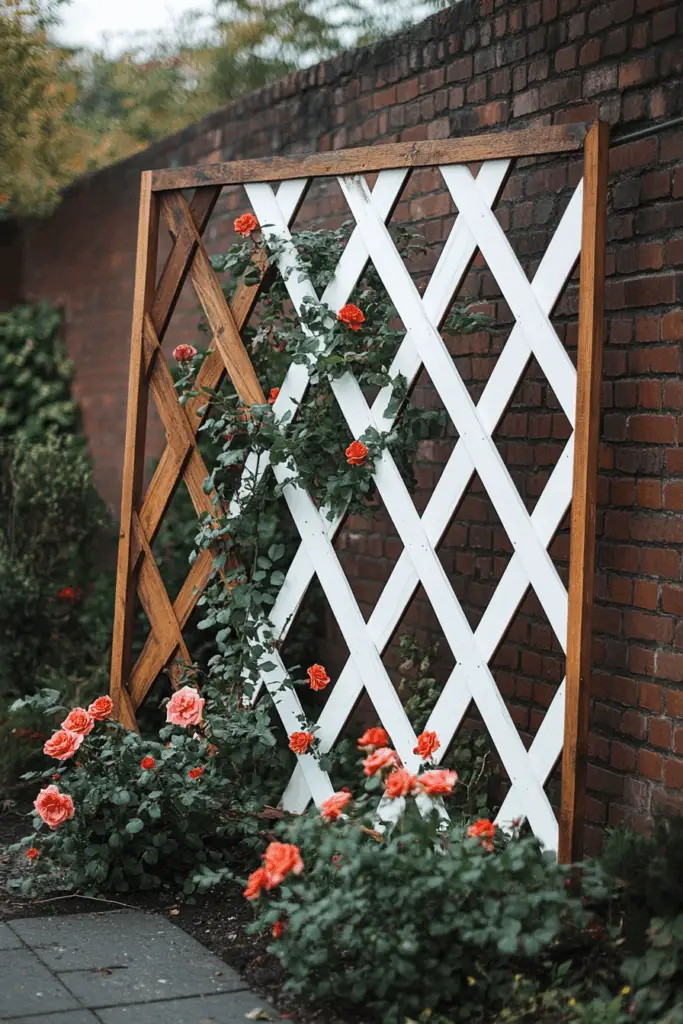
Materials Needed:
- Wooden slats or lath (cedar or redwood are great for outdoor use)
- Nails or exterior-grade screws
- Wood glue
- Saw and measuring tape
- Optional: Paint or wood stain
Why You’ll Love It:
If you’re looking for something decorative and functional, a chevron-patterned trellis brings serious style to your garden. The zigzag layout isn’t just visually striking—it also provides ample support points for climbing plants like jasmine, sweet peas, or bougainvillea.
This trellis works well as a stand-alone garden feature, against a fence, or as a focal point in a courtyard. It’s a fantastic choice for design-forward gardeners who want to elevate their space while still providing practical plant support.
Pro Tip:
Measure and pre-cut all pieces before assembly for clean angles and symmetry. Want to match it to your home’s aesthetic? Stain or paint the slats to coordinate with your garden palette.
7. Repurposed Bicycle Wheel Trellis
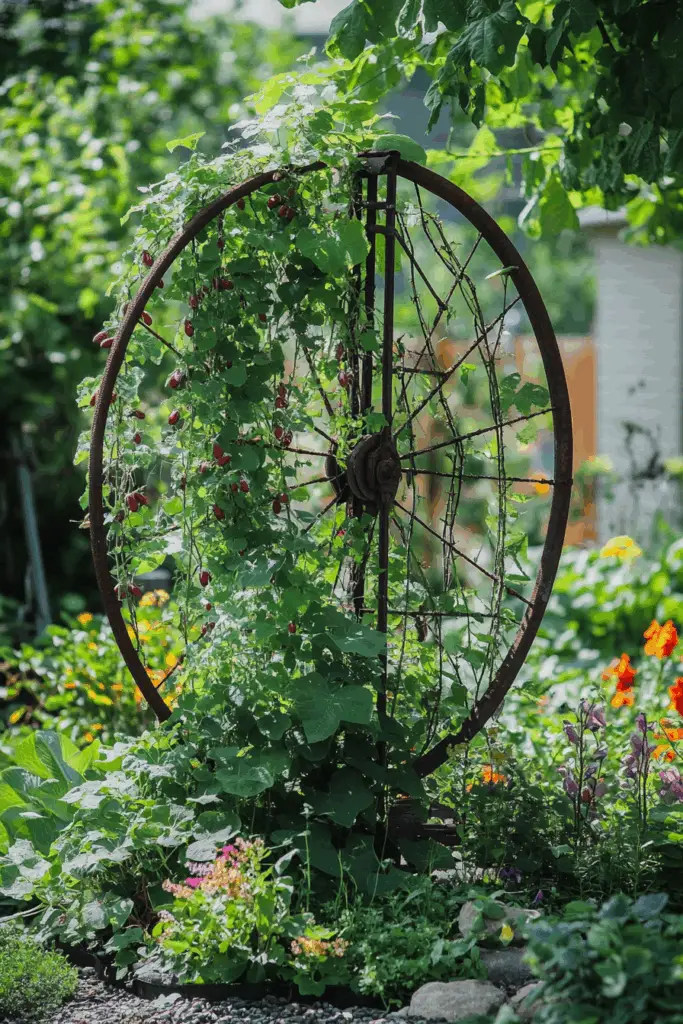
Materials Needed:
- Two or more old bicycle wheels (rim and spokes intact)
- Metal or wooden post
- Zip ties, wire, or screws for mounting
Why You’ll Love It:
A bicycle wheel trellis isn’t just a clever use of recycled materials—it’s a conversation starter. The circular frame and radiating spokes provide an eye-catching, artistic look while offering plenty of grip for climbing plants like beans, sweet peas, or even ornamental vines.
Mount the wheels vertically between two posts, stack them, or arrange in a spiral design to create visual interest and vertical growing space. It’s a great way to bring sustainability and creativity into your garden.
Pro Tip:
Look for old bike wheels at thrift shops or bike repair shops—they’re often free or super cheap. If you want to add extra support for heavier climbers, thread garden twine between the spokes to create a denser climbing surface.
8. Bamboo Teepee Trellis
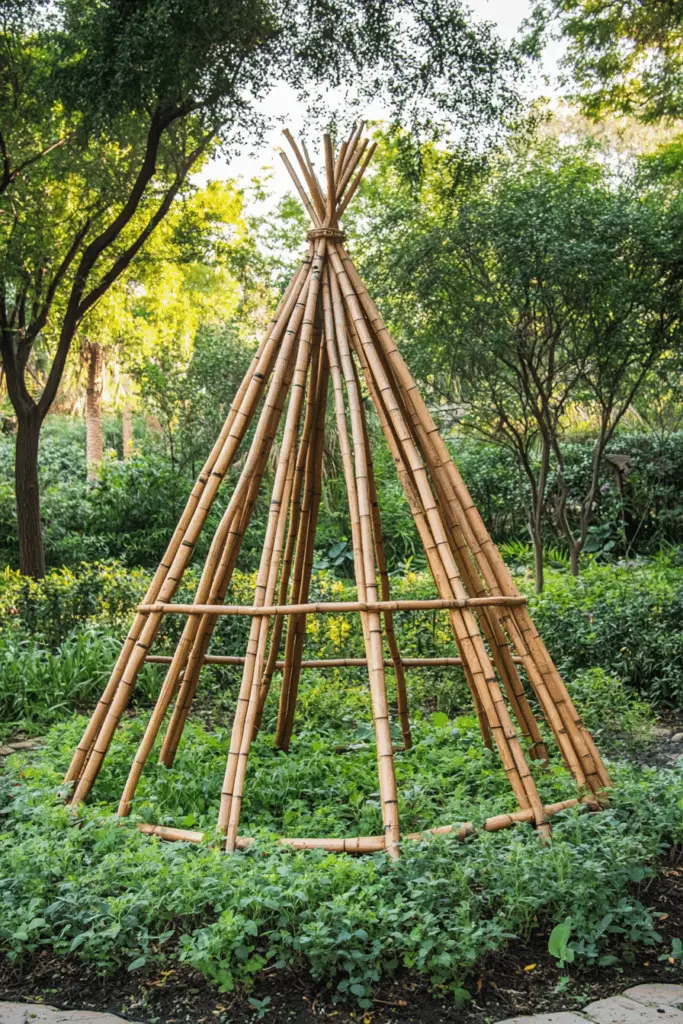
Materials Needed:
- 5 to 7 bamboo poles (5–8 feet long)
- Garden twine or zip ties
- Optional: Small stakes for anchoring
Why You’ll Love It:
A bamboo teepee trellis is one of the simplest and most effective structures you can build for your garden. It’s lightweight, biodegradable, and blends beautifully with natural surroundings—perfect for cottage-style or organic gardens.
To build it, gather the bamboo poles at the top and lash them together with strong garden twine, forming a cone or teepee shape. It’s especially ideal for supporting lightweight climbers like snap peas, pole beans, and morning glories. Plus, kids love ducking under the leafy canopy as it grows!
Pro Tip:
For extra stability, bury the bottom of each pole a few inches into the soil or secure them with stakes. You can even run horizontal twine circles around the teepee to create more grip points as your plants climb.
9. Rustic Branch Trellis
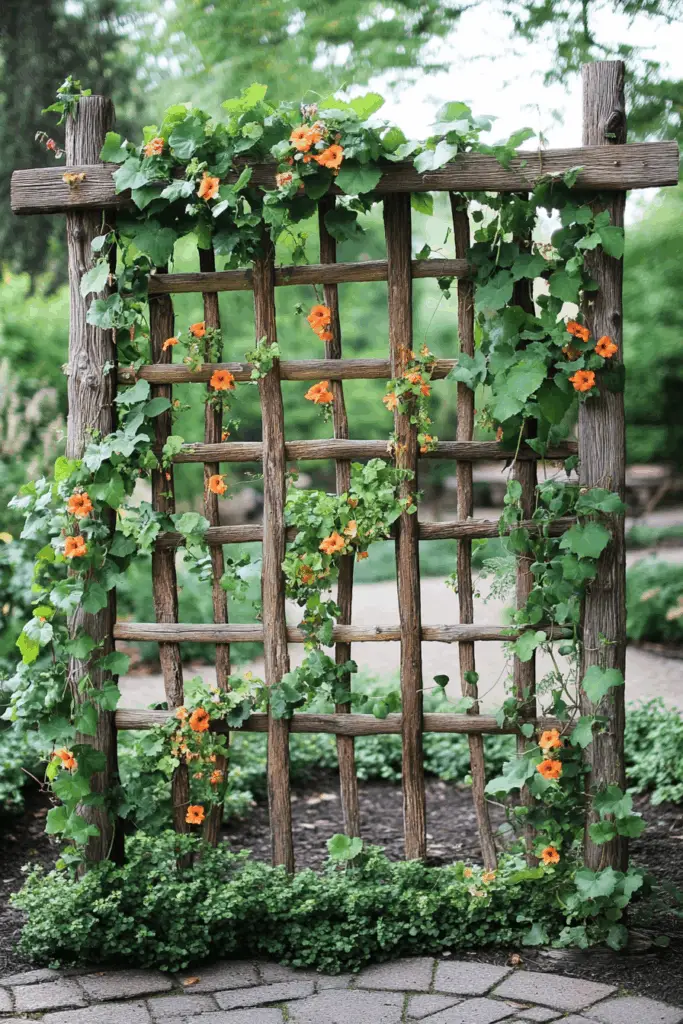
Materials Needed:
- Long, straight branches or young saplings
- Garden twine, jute, or wire
- Pruners or a small saw
Why You’ll Love It:
A rustic branch trellis brings a back-to-nature charm that feels right at home in woodland gardens or naturalistic landscapes. It’s made entirely from gathered materials, making it a cost-free and sustainable project that looks effortlessly organic.
You can build it as a fan, A-frame, or lattice-style trellis using branches of similar thickness. Secure them together with twine or wire for a sturdy structure. It’s perfect for delicate climbers like sweet peas or nasturtiums, and it will naturally decompose over time, enriching the garden without leaving waste.
Pro Tip:
Use freshly cut saplings or flexible branches for easier bending and shaping. Seal the base of the branches in the soil or attach them to a fence for extra support.
10. Classic Wooden Lattice Trellis
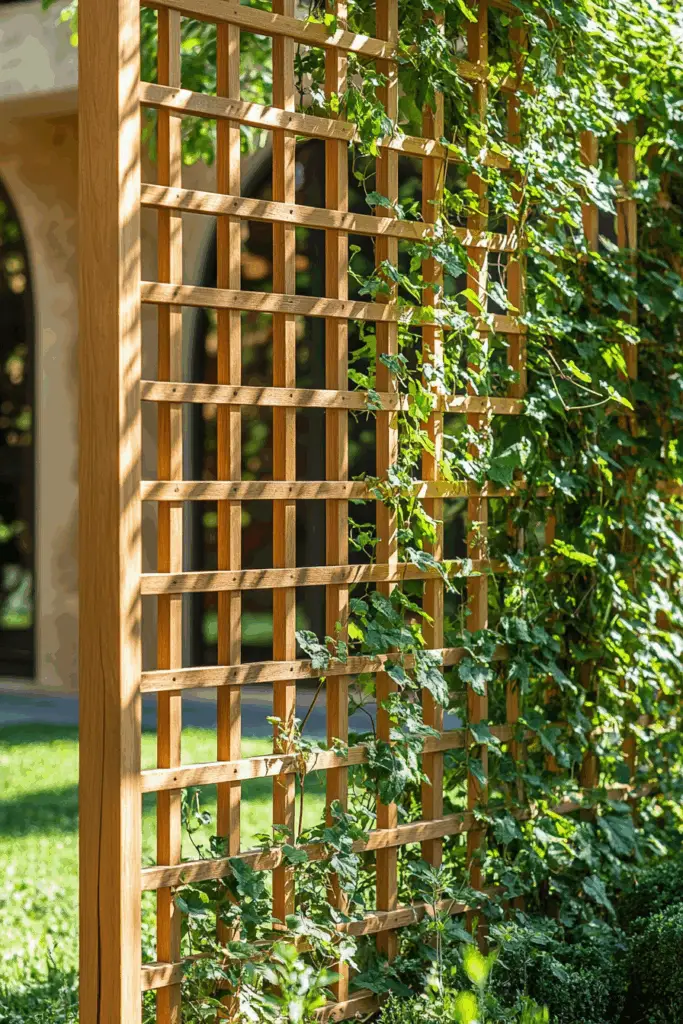
Materials Needed:
- Wooden strips (cedar or treated lumber preferred)
- Screws or nails
- Saw and measuring tape
- Optional: Wood stain or paint
Why You’ll Love It:
The classic wooden lattice trellis is a go-to favorite for a reason. Its crisscross pattern offers excellent support for a wide range of climbing plants—from roses to ivy—and adds a clean, symmetrical aesthetic to any garden setting.
This trellis is incredibly versatile: mount it to a wall, install it as a garden divider, or use it as a privacy screen along a patio or fence. The size, spacing, and finish can all be customized to match your garden’s style, making it both functional and beautiful.
Pro Tip:
Use rust-resistant screws and seal the wood with exterior-grade paint or stain to extend its lifespan. If you’re installing against a wall, leave a small gap behind it to allow air circulation and avoid mold buildup.
Conclusion
With so many creative and practical DIY garden trellis ideas to choose from, enhancing your garden’s beauty and productivity has never been easier. Whether you prefer the rustic appeal of a branch trellis, the modern flair of a chevron pattern, or the sustainable charm of upcycled bicycle wheels, there’s a trellis style to fit every gardener’s needs and personality.
Not only do trellises help support healthy plant growth, but they also add vertical interest and character to your outdoor space. By building your own, you’ll save money, express your creativity, and enjoy the satisfaction of a truly personalized garden upgrade.
So grab your tools, pick your favorite design, and let your garden climb to new heights!


